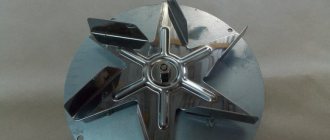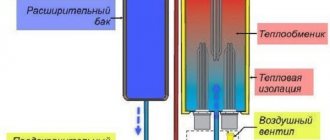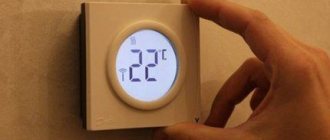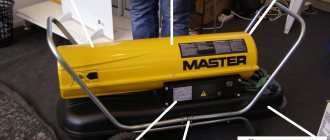With the help of these devices, it is possible to track the actual consumption of thermal energy, and when paying for the consumed heat, good savings are obtained. After installing individual metering devices, each apartment owner has a desire not only to save resources, but also to take measures aimed at insulating the premises. The advantages are obvious, and many consumers decide to install the device in their home. At the same time, many are concerned about a number of questions - when will the costs of heating meters pay off, and which device is better to install.
The feasibility of installing meters
Heating costs increase every year, and many decide to install an individual heating meter. It is quite possible to do this if a common house accounting unit is installed on the house. Another condition is horizontal heating distribution. The problem is that most apartment buildings have vertical wiring; there are risers in the rooms that feed the radiators. In this case, the meter will have to be mounted on all risers, and this is not a cheap undertaking.
For owners of horizontal wiring, installing heating meters in your apartment will bring undeniable benefits, which will depend only on the heat losses in your room. If your apartment is not a corner one, it has few walls bordering the street, windproof windows are installed, and the front door is well insulated - the benefits will be great. By installing an accounting device, you can see for yourself that the new fee will be significantly less than the charges on a general basis.
That's not all. Today, payments for heating are calculated according to metering devices only when they are installed and put into operation in all apartments and non-residential premises of your house. In reality, this is for newly built houses that are already rented with installed appliances. In other houses, such cases are still rare, and this continues to cast doubt on the advisability of such actions.
The procedure for legal installation of a heat meter
The legislation does not prescribe mandatory standards for heating meters per apartment. But the law specifies the procedure that must be followed to install a heat meter:
- Write a statement to the organization that supplies heat to your home. Specialists will check the possibility of carrying out this procedure from a technical point of view. After checking, if everything is fine, then you will receive technical support. conditions that specify the nuances of developing and installing a meter in your apartment.
- If you have created a condominium association, then its chairman needs to provide a copy of the application and clarify the process of installing the heat meter.
- Find an organization that develops projects for installing heat meters, check that they have all the documents confirming their qualifications in this matter.
- Approve the project from the company that supplies heat, then contact the company that installs heat meters.
- The installed equipment must be shown to the heat supply company and an agreement must be signed with them. A specialist from this company will service the heat meter, but at your expense. From now on, you will pay for the actual heat you use.
For reference: the meter will count the heat consumption only for your apartment, but you will be required to pay part of the amount for heating the non-residential premises of the house, along with other residents.
Principle of operation
The operation of heat meters for heating for apartments is based on calculations of consumed thermal energy using information obtained from a flow sensor and two temperature sensors.
The dependence of the amount of thermal energy on the difference in temperature and water flow is determined by the usual formula Q = G (t1 - t2), Gcal/h, in which G is the mass flow of the coolant, t1 and t2 are the water temperature at the inlet and outlet of the circuit .
The formula shows that to calculate the amount of thermal energy, you will need information about the amount of coolant consumed and the temperature difference by which the cooling occurred.
Information about the consumed coolant is determined and transmitted using the calculator of the heat meter flow sensor, and information about the temperature is transmitted by temperature indicators installed at the input and output of the system.
The computing element processes the information received from the connected sensors according to the specified formula and transfers the measured values to the archive. Data on consumed heat is recorded visually or transmitted to a computer using a special removable device.
How to convey testimony correctly
An apartment heat meter is functionally much simpler than a modern mobile phone, but users periodically have misunderstandings about the process of taking and sending display readings.
To prevent such situations, before starting the procedure for taking and transmitting readings, it is recommended to carefully study its passport, which provides answers to most questions related to the characteristics and maintenance of the device.
Depending on the design features of the device, data is collected in the following ways:
- From the liquid crystal display by visually capturing readings from various menu sections, which are switched by a button.
- ORTO transmitter, which is included in the basic package of European devices. The method allows you to display and print extended information about the operation of the device on a PC.
- The M-Bus module is included in the delivery of individual meters in order to connect the device to the centralized data collection network of heat supply organizations. Thus, a group of devices is combined into a low-current network using a twisted pair cable and connected to a hub, which periodically polls them. Afterwards, a report is generated and delivered to the heat supply organization, or displayed on a computer display.
- The radio module included in the delivery of some meters transmits data wirelessly over a distance of several hundred meters. When the receiver comes within range of the signal, the readings are recorded and delivered to the heat supply organization. Thus, the receiver is sometimes attached to a garbage truck, which, as it follows a route, collects data from nearby meters.
Archiving of readings
All electronic heat meters store in the archive data on accumulated indicators of thermal energy consumption, operating and idle time, coolant temperature in the forward and return pipelines, total operating time and error codes.
As standard, the device is configured for various archiving modes:
- hourly;
- daily;
- monthly;
- annual.
Some of the data, such as total operating time and error codes, can only be read using a PC and special software installed on it.
Transfer of readings via the Internet
One of the most convenient ways to transmit readings of consumed thermal energy to institutions for its accounting is transmission via the Internet. Its convenience and practicality lies in the ability to independently control payments and debts, as well as track heat consumption at different periods without standing in queues and spending a small amount of time.
To do this, you must have a personal computer connected to the network and the address of the website of the controlling organization, as well as the login and password of your personal account, after logging into which a form for entering readings will open. To prevent disagreements from arising in the event of a possible failure or malfunction on the site, it is advisable to take “screenshots” of the screen after entering information.
Types of heat meters
There are several types of apartment heating meters. Each of them has certain disadvantages, there is no ideal option, but you have to make a choice. We suggest considering the technical characteristics and features of each device.
Mechanical
Their second name is tachometer. In essence, they resemble simple water meters - they have an impeller under the housing cover. According to the installation option, such devices are divided into turbine and screw. The devices react poorly to mechanical impurities in water, so a coarse filter is installed at the coolant inlet. The advantage of meters of this type is their reasonable cost, which makes them popular.

Mechanical heat meter
Electromagnetic
Devices with a wide functional range, but are more expensive than other types. If there are impurities in the water, the accuracy of measurements decreases.
Vortex
There is a small obstacle inside the meter, after which the coolant begins to swirl in vortices. The forward speed of hot water is determined by the speed regime of their movement. The main difference from other devices is that vortex models are installed between the supply and return pipes.
Ultrasonic
Such heat meters for heating are high-precision devices and are quite expensive. Estimation of the amount of thermal fluid is based on the speed of passage of ultrasound. Structurally, the device consists of two parts, installed on the supply and return. The accuracy of measurements will deteriorate if there are mechanical impurities or air bubbles in the water, so it is recommended to install a filter in the supply in front of the device.
When purchasing a meter, you need to pay attention to the quality certificate, which contains information about the verification of the device. In addition, the document contains the date of verification and the name of the organization that performed it.
What types of heating meters are there?
Let's look at what types of heat meters there are. Such products are distinguished by two characteristics - the principle of operation and the installation location. The classification of heating meters according to the latest one is shown in the table below.
Table. Types of heating meters at the installation site.
Attention: The internal data of table “99” is corrupted!
According to the principle of operation, heating meters are divided into several types.
Mechanical (tachometer) heating meters
Operating principle: the main working element of such a device is a rotor or impeller, which rotates under the influence of water flow in the supply pipe of the heating system. Depending on the volume of coolant passing through it, the rotation speed of the meter rotor changes. The number of revolutions of the working element per unit time is then converted into the amount of water passing through the heating battery. Next, thermometers and a computing unit come into play.

Mechanical heating meter
Advantages: simplicity of device, lowest cost among all heat meters.
Disadvantages: during installation, a mechanical heating meter requires the installation of a filter. Also, such devices are very sensitive to the quality of water and the content of foreign impurities in them. Mechanical heat meters can become unusable if a sufficiently powerful water hammer occurs in the heating system.
Electromagnetic heating meters
Operating principle: an electromagnetic field is created at the installation site of the device in the supply pipe of the heating network. Water passing through it excites an electric current, which is recorded by the corresponding meter sensors. In addition, due to the difference in currents at the input and output of the heating system of an apartment or house, it calculates the temperature change. Then all the data enters the computing unit, which converts it into the amount of heat spent on heating the home.

Electromagnetic heating meter
Advantages: wide functionality, the ability to display a large amount of data on a liquid crystal display, high accuracy of measuring the amount of water and heat. The device is suitable for installation on a wide variety of pipe sections.
Disadvantages: high price of the device, sensitivity to iron content in water. In addition, the electromagnetic heat meter requires qualified maintenance and regular cleaning of the flow meter. Otherwise, the device begins to give false readings.
Vortex heating meters
Operating principle: an obstacle connected to the meter is placed in the supply line, and turbulence is formed in the water passing through this obstacle. Their parameters, namely the speed and number of vortices, directly depend on the coolant flow rate per unit time.
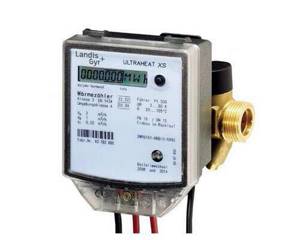
Vortex heating meter
Advantages: low sensitivity of the meter to water contamination, average cost, fairly high measurement accuracy, the ability to install the device on both horizontal and vertical sections of the supply pipe.
Disadvantages: if there are a large number of air bubbles in the heating system along with water, the device begins to give false readings and make mistakes.
Ultrasonic heating meters
Operating principle: an emitter and receiver of an ultrasonic signal sent inside the pipeline are installed in the heating system pipe. The time difference between generation and reception directly depends on the flow rate in the supply pipe of the heating system. Based on these data, the computer determines the amount of water that has passed to the batteries. Often installed as a general house heat meter.

Ultrasonic heating meter
Advantages: the highest accuracy among all other heat meters. Often such devices have functionality for regulating the flow and changing the temperature of heating radiators. Under proper conditions, ultrasonic heat meters have a long service life.
Disadvantages: such devices are very sensitive to low-quality and contaminated water - upon contact with it they quickly become unusable. They require the proper level of maintenance and the mandatory presence of a filter in front of the meter itself.
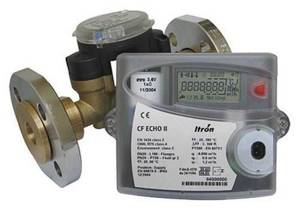
Ultrasonic counter
Criterias of choice
Let’s figure out what basic criteria are used to select a heat meter:
- certification - the device must be registered in the State Register of Measuring Instruments and checked for accuracy,
- measurement error - it should not be more or less than four percent if the temperature difference is from twenty degrees,
- error when measuring mass - deviations within two percent are allowed here. A significant role is played by the ability of the counter to determine the mass difference,
- flow measurement range - according to the norm, it should be no lower than 1 in 25,
- temperature range – normatively defined as no more than 200 degrees,
- indication of temperature difference measurements - previously the value was at least 10 degrees, for modern models the indicator is set to 3 degrees,
- pressure loss – in the flow converters of heat meters there is resistance to hydraulic pressure,
- length of straight pipes - many types of devices require a significant length before and after the installation point,
- recording pressure and temperature indicators - almost every model has this option for temperature, and for pressure - some,
- measuring channels - meters are measuring systems that carry out a full list of functions for measuring heat and mass, pressure and temperature, and the duration of normal operation.
In addition, when choosing a metering device, the consumer is recommended to clarify what capabilities the heat meter has:
- archive and its depth,
- diagnostic system – independently checks the performance of the heating device,
- availability of communication with a computer,
- energy independence,
- intervals between checks,
- operating conditions for taking readings,
- delivery set,
- warranty periods,
- cost of the device.
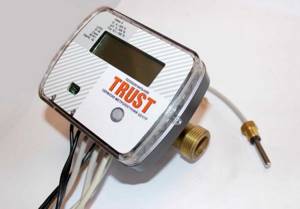
When choosing a heating meter, consider its archive and depth
Technical installation limitations
If we talk about apartment buildings built a long time ago, then in almost all of them the heating system is installed vertically. This means that there are several risers running through the apartment, and it is not profitable to install heat meters for heating on each of them. For such systems, it is proposed to install distributors that measure the flow of coolant based on the difference in temperature in the room and on the radiator. The cost of one such distributor is about one thousand rubles. Installation costs can reach from two to six thousand, depending on the completeness.
Features of heat meter installation
Let's figure out how to install a heating meter.
To start the heating season with an installed metering device, it is recommended to start acting in advance. The order is as follows:
- it is necessary to contact the housing and communal services, which issues technical conditions for connecting the metering device. All parameters for temperature and network pressure will be indicated on one sheet,
- After this, the device is purchased. It is best to do this in a legal organization so that the meter is certified for quality. The receipt is saved, the date of verification is checked in the certificate,
- a design organization that has the right to perform these services is selected. Based on the existing technical conditions and the purchased device, a project is drawn up,
- With a ready-made design task, you are looking for an organization that will install devices. She coordinates the time of work with the Housing Office. It will be better if they are performed at a time when there is no water in the heating system. This will help save not only time, but also money,
- installation is completed quickly, within two hours. You will first have to prepare a place for welding work,
- as soon as the installation work is completed, go with all the documents to the housing office so that they accept the meter for operation. At the appointed time, their representative will come to you, seal the device, draw up a commissioning certificate, and give you one of its copies. All that remains is to conclude a payment agreement, and you can pay for the consumption of thermal energy using the meter.
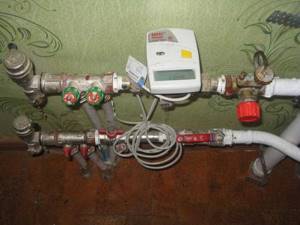
Installed heat meter
The whole process takes from two to three months, so such activities should be started in advance in order to get everything done before the start of the heating season.
If you don’t have free time, you can find an organization that will do all the design and installation work for you. Only such services will cost much more.
How to install a meter?
People often ask whether it is possible to install a heating meter on their own. Russian legislation prohibits the installation of control and measuring equipment by organizations and individuals who do not have a certificate or permit to carry out this type of work. Accordingly, to install a thermal energy meter, you need to contact a certified company, the list of services of which includes the relevant work.
When choosing a meter, you should pay attention to such characteristics as the maximum permissible temperature and pressure level; they must correspond to the parameters of the central heating system of the house. The technology for correct installation of the metering device itself is described in the project plan developed on the basis of technical documentation
The drafting must be carried out by an organization that has permission for this type of activity. The project must be agreed upon with the regulatory authority, and only then and only then can its implementation begin.
The meter can only be installed if all conditions are met
:
- there is permission from the organization supplying heat energy to the house;
- the balance holder drew up specifications for the work;
- a certified company has been selected that provides installation services for metering devices;
- The contractor's specialists prepared the design documentation and approved it with the regulatory authorities.
After installing the device, it is necessary to conclude an agreement with the organization supplying heat to the house to record the amount of thermal energy consumed by the meter. Representatives of this organization check and seal the device and put the meter into operation.
A consumer who has installed a heat meter independently will not be able to approve the installation with regulatory authorities and the readings from the device will not be taken into account.
Installation work must be carried out by professionals from the design and installation organization. This ensures that precision measuring equipment is installed correctly. If you install the meter yourself or entrust it to a technician who has not undergone special training, there is a high risk that a possible defect in the installation process will affect the accuracy of the meter readings.
During installation work, it is necessary to take into account many rules and requirements, in particular
:
- It is not allowed to use a welding machine when installing a meter with an ultrasonic flow meter;
- temperature sensors must be installed strictly in the prescribed places;
- the device must be freely accessible for maintenance and readings;
- the device must be mounted on a flat section of the pipeline in order to eliminate wave disturbances during the movement of the coolant; the minimum permissible length of the flat section before and after the meter depends on the model of the device;
- the temperature-sensitive element of the device must be located in the center of the cross-section of the pipeline;
- to prevent airing from affecting the meter readings, an air vent valve is installed in front of the device;
- to simplify the installation and dismantling of the device, ball valves are mounted on the pipe before and after it;
- It is recommended to install a filter in front of the device so that the meter is not damaged by mechanical inclusions in the coolant.
So, when purchasing housing in a new building, pay attention to the layout of the central heating pipes. If the apartment has one supply pipe, from which the coolant is distributed to all heating devices, then it makes sense to obtain permission to install an individual meter. In this case, thermal energy will not be wasted, and you will only pay for the heat you use
In this case, thermal energy will not be wasted, and you will only pay for the heat you use.
Video on the topic:
Registration and verification
If a meter for a heating system is installed by a licensed company that is capable of independently and professionally completing design documentation, installation work and subsequent maintenance of metering devices, its specialists will be able to carry out the full range of required measures, up to registering the metering device and putting it into operation.
A new heat metering device is sold with an initial check, which is carried out by the manufacturer. Confirmation of such an event is a special mark in the form of a sticker and a corresponding entry made both on the device and in the accompanying documentation.
The next test of the device is performed after the test interval has expired. In such cases, owners should contact:
- to local departments,
- commercial organizations with similar powers,
- to manufacturers' service centers.
Most companies that sell heat metering devices perform their subsequent maintenance, taking on the functions of organizing the next verification.
Checking heat meters
Typically, new devices are sold with an initial test, which is carried out at the factory that produces them. Proof that the verification of heat meters has been carried out is the presence of a special sticker corresponding to the entry, a special mark, both on the devices and in the documents attached to them.
During operation, verification of heating meters is carried out at the expense of apartment owners once every 4 years; to carry it out, you must contact a number of organizations and institutions:
- to the Rostest department;
- to a company that has the appropriate authority to carry out the inspection;
- to the service center of the manufacturer.
They independently take readings from the heating meter in the same way as from the electric meter. The payment receipt indicates the difference in readings, multiplies it by the established tariff and makes the payment, for example, in one of the Sberbank branches. The recipient of the payment is the heat supply organization. Heat meters - installation advantages, detailed video:




